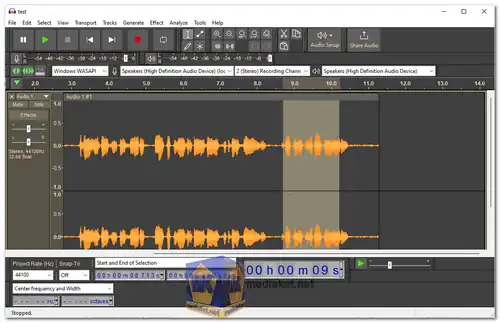Audacity is a free, open-source, multi-track audio editing and recording software that is available for various operating systems, including Windows, macOS, GNU/Linux, and others. Its user-friendly interface, support for multiple languages, and extensive feature set make it a valuable tool for users from various backgrounds, including musicians, podcasters, and those interested in digitizing and editing audio recordings...
Features of Audacity:
Recording:
Audacity allows users to capture live audio using a microphone or mixer, as well as digitize recordings from other sources. This versatile recording feature supports multiple formats and sample rates.
Import / Export:
Users can import, edit, and combine sound files in various formats, including WAV, AIFF, FLAC, MP2, MP3, Ogg Vorbis, AC3, M4A/M4R (AAC), and WMA. Audacity enables exporting recordings in multiple file formats simultaneously.
Sound Quality:
Audacity supports 16-bit, 24-bit, and 32-bit audio files. It uses high-quality resampling and dithering when converting sample rates and formats, ensuring excellent sound quality.
Plugins:
The software supports a wide range of audio effect and generator plugins, including LADSPA, LV2, Nyquist, VST, and Audio Unit. Users can also write their own custom plugins using Nyquist or modify existing ones to meet their specific needs.
Editing:
Audacity provides essential editing functions, such as Cut, Copy, Paste, and Delete. It also features an unlimited sequential Undo and Redo, allowing users to backtrack through any number of editing steps in a session.
Real-Time Effects:
Users can preview real-time effects from LADSPA, LV2, VST, and Audio Unit (macOS) plugins. The Plug-in Manager simplifies the installation and management of these effects.
Accessibility:
Audacity offers accessibility features, including keyboard shortcuts and keyboard-based manipulation of tracks and selections. This ensures that it's usable by individuals with disabilities.
Analysis:
The software includes a Spectrogram view mode for visualizing and selecting frequencies, as well as a Plot Spectrum window for in-depth frequency analysis.
Multi-Track Editing:
Audacity supports multi-track editing, allowing users to work with and manipulate multiple audio tracks simultaneously. This feature is invaluable for creating complex audio compositions.
Customization:
Audacity is highly customizable, and users can tailor the interface and workflow to their preferences. This flexibility makes it suitable for both beginners and experienced audio editors.
64-Bit Support:
The Windows version of Audacity is now 64-bit, enhancing performance and compatibility with modern systems. However, it's important to note that 32-bit plugins will not work on the 64-bit version of Audacity.
Improved Spectrogram Colors:
Audacity features enhanced default spectrogram colors for better visualization and analysis.
Linux Binary:
An official binary for Linux in the form of an AppImage is provided for easier installation on Linux systems.
Update Checking:
Audacity can now check for and notify users about the availability of newer versions, keeping the software up-to-date.
Error Reporting:
Users have the option to send details about serious errors encountered, which can assist in improving the software's stability.
Bug Fixes:
Multiple bugs have been addressed, enhancing the overall performance and reliability of Audacity.
Audacity is a versatile and feature-rich audio editing and recording software that caters to a broad user base. Its combination of essential editing functions, support for numerous audio formats, plugin compatibility, and accessibility features makes it an indispensable tool for anyone working with audio content. Furthermore, the continuous development and improvements, along with its open-source nature, ensure that Audacity remains a prominent choice in the field of audio software.
Audacity - Changelog:
For windows 32 bit:
Install version - Size: 13.95 MB - Download
Portable version - Size: 20.62 MB - Download
For windows 64 bit:
Install version - Size: 15.34 MB - Download
Portable version - Size: 22.48 MB - Download
How to use Audacity?
To use Audacity, you will first need to download and install the software. Once installed, open Audacity and you will be presented with a blank project.
To record audio, click the red record button. You can record from your microphone or from another audio input device, such as a mixer or CD player. To stop recording, click the stop button.
Once you have recorded some audio, you can begin editing it. Audacity provides a variety of editing tools, including cutting, pasting, trimming, and mixing. You can also apply effects to your audio recordings, such as equalization, compression, and reverb.
To export your finished audio recording, click the File menu and select Export. You can export your recording in a variety of formats, including MP3, WAV, OGG, and FLAC.
Here is a more detailed guide to using some of the basic features of Audacity:
Recording audio:
1. Click the red record button.
2. Start speaking or playing the audio you want to record.
3. Click the stop button when you are finished recording.
Editing audio:
1. Select the section of audio you want to edit using the Selection tool.
2. Click the Edit menu and select the desired editing option, such as Cut, Copy, or Paste.
3. You can also use the Effects menu to apply effects to your audio recordings.
Exporting audio:
1. Click the File menu and select Export.
2. Select the desired export format from the drop-down menu.
3. Click the Export button to save your audio recording.
Audacity also has a number of more advanced features, such as multi-track recording, labeling, and spectrograms. However, the basics of using Audacity are relatively simple, even for beginners.

